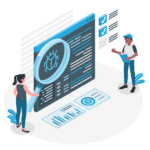Data Preparation Best Practices & Steps for 2023
Before organizations can leverage emerging technologies like artificial intelligence and machine learning, they need to put in the work to prepare their data. When businesses undertake data preparation, they extract, clean, standardize, and enrich raw data sets, improving data quality for use in AI, machine learning, and data science workloads.
The Steps of Data Preparation

The various data preparation steps include:
- Data cleansing: Removing inaccurate, duplicate, and out-of-date information from data sources.
- Data transformation: Structuring data to fit the schema of the target data warehouse.
- Data enrichment: Supplementing existing information with other data sources, internal and/or external, to make data sets complete.
The final destination of the data preparation process is typically a centralized repository, such as a data warehouse. Collecting clean data in a single location makes it much easier for business users to use this information in data analysis.
The Challenges of Data Preparation
Unfortunately, data prep can be highly complex and time-consuming for data scientists and engineers. According to a 2020 survey, data scientists spend roughly 45 percent of their day on data preparation—far more than the time spent on any other task in a typical workday.
Despite the challenges of data preparation, it remains essential for accurate analytics, reporting, and predictive modeling. Business intelligence and analytics processes that lack high-quality data can produce the wrong conclusions, painting an inaccurate picture of business performance that leads to ill-informed decisions. Data preparation issues can even impact the end-user experience, resulting in poor recommendations and limited personalization.
For these reasons, companies must invest in data preparation as a critical component of good data management. This article discusses three data preparation best practices that businesses of all sizes and industries should follow.
1. Invest in Dedicated Data Preparation Resources

Data preparation is an ongoing process. Whenever organizations gather more information, add data sources, or develop new models, their data preparation processes must continue to maintain high-quality input data.
Data-driven companies must invest in dedicated data preparation resources to ensure the long-term health of their data ecosystem. Depending on their situation, companies may wish to hire an internal team of data experts or join forces with an IT partner offering data preparation services. They should also consider cost and scalability issues when deciding between internal and external data preparation teams.
Data Prep Costs
Hiring an on-staff team of data experts is expensive—not only for the full-time salaries and benefits but also for hiring, onboarding, and training expenses. A data services provider can be more cost-effective, especially if the company only has part-time data prep needs.
Data Prep Scalability
Scalability is another reason many businesses prefer an external partner over an internal team. If data preparation needs are highly variable or unpredictable, a fixed-size team can easily become overwhelmed during times of high demand. Partnering with a data services provider can ensure access to the resources and skill sets needed at any particular time.
No matter if the organization hires internal staff or uses external data preparation services, a dedicated team is essential to maintaining the quality and integrity of data. This team also helps guard against any bias or oversights that could cloud the results of analytics workloads.
2. Build the Right Data Infrastructure for Each Use Case

Becoming a “data-driven” organization is easier said than done, and businesses can’t brute-force their way into making it happen. Buying the right tool or selecting the correct algorithm is only part of the process—it must also mesh with the organization’s data preparation.
For example, visualizations such as graphs and charts excel at representing structured numerical data, but they are entirely incompatible with unstructured data, such as text and images. Meanwhile, numerical data can be misleading without the proper context—as the old saying goes, there are “lies, damn lies, and statistics.” Teams must also correctly account for factors such as seasonality, elasticity, and other influences when drawing conclusions and making decisions.
As such, data preparation considers both ends of the process: the input data and the different types of analysis it will run. Companies should ask themselves what questions they are trying to answer and what they need to answer each one. Whatever the decision, an organization must ensure that the data preparation process helps facilitate the desired result.
3. Monitor Cloud Usage

Cloud monitoring may not strictly fall under data preparation. As big data and cloud computing become ever more closely intertwined, it’s clear that cloud monitoring is now a critical part of maintaining data preparation infrastructure.
According to Statista, 60 percent of corporate data is now stored in the cloud—up from 43 percent just five years earlier. What’s more, according to Flexera’s 2022 State of the Cloud report, 41 percent of organizations are now using a multi-cloud strategy for their data, performing data integration between two or more public clouds.
Organizations must have the right plans, strategies, and tools in place to monitor their cloud storage resources and processes. This approach will keep everything running smoothly, helping optimize the data preparation pipeline and fix bugs and performance issues.
Data Preparation Best Practices with KMS Technology
KMS is a global market leader in software development, technology consulting, and data analytics engineering. We provide a wide range of IT offerings and a team of skilled, knowledgeable advisors who can help organizations develop data preparation steps and make the best use of big data.
Our list of data analytics services includes:
- Selecting the right ETL, data storage, and data reporting tools for an organization’s needs.
- Data engineering to build and optimize production-ready data pipelines.
- Running data-driven analytics workflows to help businesses gain a competitive advantage.
KMS Technology is an all-in-one data services provider, with offerings ranging from data storage and cleanup to advanced analytics and artificial intelligence. Do you want to learn how KMS can help you harness the power of your data for smarter business decisions? Schedule a free consultation today to discuss your business needs and objectives.








